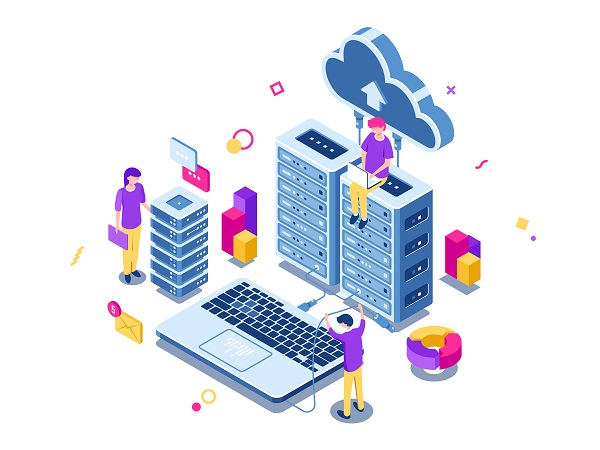Past, Present, and Future of Cloud Computing Services
Cloud computing- today, this concept has become inevitable for the corporate world. We just cannot imagine the growth of modern businesses without implementing cloud computing solutions. This futuristic technology is a base of utility computing, application building, and other advanced approaches like SaaS (Software-as-a-Service) and PaaS (Platform-as-a-Service).
Here we are going to see the history of the cloud concept along with its current status and future. The journey of the cloud has remained interesting to date. Though the approach has started gaining ground in the corporate sector from the 2000s, its foundation was laid some 40 years back.
History of Cloud Computing- 1960s to 1990s

It all started in the 1960s with the advent of Remote Job Entry (RJE). However, some consider the rise of terminal computing in the 1970s as the first phase of cloud computing. Others would say that the most credible claim for the beginning of cloud computing services might be the development of Telescript by General Magic.
As highlighted in the quote of Andy Hertzfeld in one of the articles of Wired magazine in the year 1994- “The beauty of Telescript, is that now, instead of just having a device to program, we now have the entire Cloud out there, where a single program can go and travel to many different sources of information and create sort of a virtual service. No one had conceived that before.”
Telescript is a precursor to Java that we know as an official programming language for developing Android mobile apps.
In the year 1969, JCR Licklider has given an idea of an Intergalactic Computing Network which was similar to the modern Internet. His vision was to keep everyone interconnected and being able to access programs and data at any site across the globe. On the basis of this notion, the concept of Virtual Machines (VMs) was developed in late 1970. It made possible to apply one or more operating systems at once in an isolated environment.
In the 1980s and 1990s, the practice of walled garden online computing was on the rise. In the US, America Online and CompuServe dominated this practice. Then in the late 1990s, the tech domain witnessed a paradigm shift from a walled to open Internet. This change brought the next phase of the evolution of cloud computing services in the form of email services like Hotmail and Yahoo! Mail. This advancement further paved the way for other cloud-based applications like Napsters and Office 365.
The advent of IaaS (Infrastructure-as-a-Service) is dated back to the early 2000s. It was aimed at enabling all-sized organizations to leverage the benefits from the scalability of cloud computing solutions without spending a lot of bucks in capital expenditures and ongoing maintenance. It further gave rise to new companies or digital startups by giving them access to cloud-based solutions at reasonable rates.
Related Reading- Reasons Why Your Business Needs to Move to the Cloud
Present of Cloud Computing- From 2000s to Present
Amazon, an eCommerce giant expanded cloud computing services in 2006 to capitalize on the advantages of the cloud. It introduced Elastic Compute Cloud to enable individuals to access computers and operate their own applications on the cloud. Today, we know it as the pay-as-you-go model.
The cloud approach can be broadly classified into three categories- Public Cloud, Private Cloud, and Hybrid Cloud. Yesterday, the cloud was considered as an approach for big and financially sound firms. Today, thanks to advancing technology, even startups can get the benefits of this revolutionary concept and disrupt the industrial scenario without investing much on digital infrastructure. The emergence of many cloud-native organizations is also attributed to the rise of cloud computing services. The cloud has made it possible for new players to outperform large and longer-established companies.
Global players like IBM, SoftLayer, and Alibaba offer public, private, and hybrid cloud computing solutions to businesses across the world. Today, as companies look to maintain applications in data centers, the concept of public and hybrid cloud will remain in focus in the coming time.
Future of Cloud- Evolution is on!
The stage is set for the bright future of cloud computing services. As the concept evolves rapidly with deployments of hybrid and multi-cloud solutions in the enterprises, we can certainly assume that terms like multi-cloud, hybrid-IT, and managed services will be things of the past in the next five years. Hybrid solutions will remain the most optimized and cost-effective for enterprises. The cloud computing solutions are based on performance needs and end-user demands along with data residency needs.
We will see the substantial rise in the public cloud, private cloud, on-premise, or a mix of all types over the period. The role of cloud service providers will remain crucial for pushing all these types of cloud-based applications. As enterprises will adapt to the hyper-scale public cloud, the concept of on-premise data centers will spread rapidly. We expect this trend to continue over the next ten years with the increased demand for customized cloud solutions.
Concluding Lines
From reliability to productivity and from cost-effectiveness to performance; the cloud computing services have them all. The concept of cloud has, therefore, a great future ahead. We, at Silver Touch, are ready to embrace the advancements of cloud computing to make robust applications that enhance the convenience and establish a centralized model. Let’s connect to discuss the scope of this futuristic technology for your business.
Recent Posts
- Hyper Converged Infrastructure- How It Benefits Modern Businesses June 17, 2024
- Your Concise Guide to Data Resilience Strategy at the Workplace April 30, 2024
- Road to Future Infrastructure- Top Trends in Data Center Modernization February 20, 2024
- How to Differentiate Cloud Types- Public vs Private vs Hybrid in 2024 January 8, 2024
- Cloud HRMS Solutions- Top Features, Benefits and Future Trends October 25, 2023
- Top advantages of VDI Solutions for your Business May 27, 2022
- Time to Reimagine the Digital Workspace April 26, 2022
- Customize Digital Workplace Services through VDI solution April 26, 2022
- Accelerate Access to Cloud Workloads & Branch Offices January 12, 2022
- Delivering A GPU Experience To Virtual Desktop January 4, 2022
Connect with us
Drop us a line! We are here to help you out
Confidential
& Secured
Confidential & Secured
- This form is Secured with Validations.
- Your Privacy is our utmost priority.
- We will not reveal any of your info.
- It will be used to contact you for Project purpose only.
Locate us
Silver Touch Technologies Limited
Silver Touch House
Opp. Suryarath Complex, Nr. White House, Panchavati Circle, Ahmedabad - 380006 Gujarat, India

